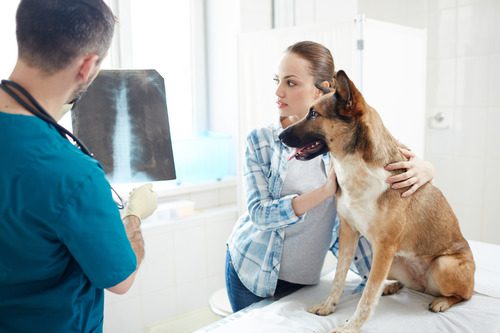Senior Pets in Pain? How Radiology Can Help Diagnose Arthritis and More
As dogs grow older, their daily routines often shift. They may sleep more, take longer to rise from their beds, or seem less eager to go for walks. While some of these changes are a natural part of aging, others could point to something deeper—such as joint pain, arthritis, or other internal issues. Radiology, particularly the use of X-rays for dogs, allows veterinarians to identify the source of pain without guesswork. At Animal Hospital of Lake Villa, our team uses advanced imaging technology to support accurate diagnoses and improve quality of life for senior pets. If you’ve noticed changes in your dog’s mobility or comfort, radiology can reveal what’s happening beneath the surface.

How X-Rays for Dogs Work
X-rays for dogs are one of the most commonly used diagnostic tools in veterinary medicine. They provide a non-invasive way to examine bones, joints, and certain internal organs. This imaging technique uses a small amount of radiation to capture detailed images of your pet’s body, making it possible to identify issues that aren’t visible during a physical exam.
What to Expect During the Procedure
When a dog receives an X-ray, the process is typically quick and painless. Your veterinarian will position your pet and take images of the target area. In some cases, light sedation may be necessary to help keep your pet still, especially if they’re anxious or experiencing pain. Once the images are taken, your vet reviews them for signs of arthritis, joint degeneration, fractures, tumors, or other abnormalities. By using an X-ray for dogs, veterinarians gain valuable insight into a pet’s condition and can make informed decisions about the next steps in care.
Signs Your Senior Dog May Benefit from an X-Ray
Older dogs often experience subtle changes that might not raise concern at first. However, these early warning signs can indicate underlying pain or joint issues that an X-ray can help identify.
Decreased Mobility and Activity
If your dog no longer enjoys going for walks or struggles to climb stairs, their joints could be the reason. Stiffness, hesitation, and a slower pace can all be signs of discomfort, especially in older dogs.
Limping or Favoring a Limb
Dogs often shift weight away from a painful area, causing them to limp or avoid using a particular leg. This behavior may come and go, but if it persists, a veterinary exam followed by an X-ray for dogs can determine the cause.
Changes in Behavior
Pain can lead to increased irritability, restlessness, or even withdrawal. Dogs who were once social and affectionate might become more reserved or avoid interaction.
Difficulty Standing or Lying Down
Arthritis and other degenerative conditions make it harder for dogs to move between positions. You may notice your pet struggling to get comfortable or hesitating before getting up. An X-ray allows your veterinarian to evaluate the extent of joint changes or look for other causes that may be contributing to these symptoms. The sooner a diagnosis is made, the sooner your pet can find relief.
Diagnosing Arthritis with X-Rays for Dogs
One of the most common conditions detected with radiology in older dogs is arthritis. Also known as osteoarthritis or degenerative joint disease, this condition causes inflammation, stiffness, and progressive joint damage. X-rays for dogs allow veterinarians to detect arthritis by revealing changes in the joints that aren’t apparent during a physical exam.
What Arthritis Looks Like on an X-Ray
An X-ray will show several signs that suggest arthritis is present. These may include:
- Narrowing of the joint space
- Irregular bone surfaces
- Bone spurs or osteophytes
- Changes in bone density
While arthritis is not reversible, identifying it early allows veterinarians to monitor progression and explore pain management strategies. Regular follow-up X-rays for dogs may also be recommended to track changes over time.
Beyond Arthritis: Other Conditions X-Rays Can Detect
While arthritis is a common finding in senior pets, radiology can uncover a range of other health concerns. An X-ray for dogs offers a deeper look into the body, making it possible to identify additional sources of pain or illness that aren’t obvious through observation alone.
Hip Dysplasia and Joint Malformations
Older dogs who were born with joint malformations, like hip dysplasia, often show symptoms later in life. These conditions cause uneven wear on joints, leading to pain and inflammation. An X-ray provides a clear view of joint alignment and can confirm or rule out these structural problems.
Tumors and Masses
Bone tumors or masses in the chest or abdomen may also be discovered during routine radiology. Though more common in certain breeds or age groups, any unexplained pain, swelling, or weight loss should prompt further investigation.
Spinal Issues
Intervertebral disc disease (IVDD), spinal degeneration, and other back-related conditions often show up in X-rays for dogs. Dogs with back pain, weakness in the hind legs, or changes in posture can benefit from imaging to locate the source of the problem.
Fractures and Injuries
Not all injuries are obvious. A small fracture or ligament injury can continue to cause pain long after the initial trauma. An X-ray makes it possible to identify even minor fractures that may need rest or further treatment.
What to Expect During Your Dog’s Radiology Appointment
If your veterinarian recommends an X-ray for your dog, the appointment typically begins with a thorough physical exam. Once imaging is approved, your dog will be positioned carefully on the X-ray table. Depending on the area being imaged and your pet’s comfort level, light sedation may be offered to reduce stress and movement.
The Imaging Process
The imaging process itself only takes a few minutes. After the X-rays are complete, your veterinarian will review the images and discuss their findings with you. In many cases, you’ll receive answers during the same visit. If additional testing is needed, such as bloodwork or ultrasound, your veterinary team will guide you through the next steps.
Clear Communication and Support
The team at Animal Hospital of Lake Villa takes the time to explain what’s being seen in each X-ray and how it relates to your dog’s health. We believe pet owners should feel informed and supported when making decisions for their senior companions.
When It’s Time to Consider Radiology for Your Senior Pet
Many pet owners wait until symptoms become severe before seeking help, but early imaging can reveal much more than you might expect. Dogs tend to mask their pain until it becomes harder to hide. If your older pet shows changes in movement, behavior, or comfort, a veterinary exam followed by an X-ray may be the right next step. X-rays for dogs allow our team to take a closer look and determine whether arthritis, injury, or another condition is affecting your pet. At Animal Hospital of Lake Villa in Lake Villa, IL, we’re here to support your senior dog’s health with diagnostic tools that deliver answers. If you’ve noticed signs of discomfort in your pet, call us today at (847) 356-8387 to schedule an appointment.
About Us
Animal Hospital of Lake Villa has provided compassionate, personalized pet care since 1993. Our Fear Free-certified, AAHA-accredited team helps every pet, even the nervous ones, feel safe and at ease.
